Personalized learning evolves at South
A picture of personalized learning up close and personal, and at its best.
December 13, 2017
Schools in Forsyth county have begun to explore the topic of, “Personalized Learning”. South Forsyth High School, along with Piney Grove Middle School, and Shiloh Elementary, are the pilot schools for personalized learning in Forsyth County. Personalized learning is aimed to encourage students to find how they learn and study best by supporting their learning needs, in order to help them become more well rounded students who are prepared to enter college and/or the workforce. Personalized learning is also intended to make the educational experience more meaningful for students so that they feel like they are participants in their educational process. At the moment, personalized learning is a diamond in the rough at South, because there are currently only 9 teachers that have fully adopted personalized learning in their classrooms as a teaching style.
Currently, Piney Grove Middle and Shiloh Elementary are feeder schools for South Forsyth High School. Many of these students will have the opportunity to experience personalized learning before they attend South. Since South is a pilot school for personalized learning in Forsyth County, it has had the opportunity to demonstrate the impact personalized learning can have. While high school varies significantly from elementary and middle school education, if the ideals of personalized learning are indoctrinated early in childhood, they can help students succeed with personalized learning in high school.
In a informational document provided by South’s principal, Laura Wilson, personalized learning is broken down into 5 basic design principles. The first principle is, Mastery-Based Learning where students regularly address individual learning targets based on level of content mastery. The second principle is Student Ownership, where students monitor their learning and review their own progress while setting goals along the way. The third principle is Authentic Experiences which is learning experiences that are relevant, rigorous, and mimic the work of professionals. As a result, assessments are now tied to demonstrating real world application of skill acquisition. The fourth principle is technology enabled, where both teachers and students use technology to support deeper learning. This principle can easily be mistaken according to Mrs. Wilson who characterizes the use of technology alongside a teacher, not in place of the teacher. The final principle is Equity by Design. In this principle, efforts are made so that students across schools and classrooms have equitable access to quality learning experiences. These are great guiding principles for South to develop and fine tune in the future.
Personalized learning has already made a positive impact in our school. For example, Ms. Nicole Barth has been making waves with the positivity that she exudes by embracing personalized learning. She has seen significant changes in her students as well. “Just from implementing personalized learning in my class last year, I have seen growth in my students mastery, time management, responsibility, etc.” If students are able to grasp these traits as young adults, they can use these skills later in life at the workplace. Students have a greater opportunity to be more successful because they are responsible for their actions and have become more well rounded individuals. Mrs. Kennel has seen an overwhelmingly positive response as well: “I think when personalized learning is presented and done well, students are highly receptive to it. They may not know what to call it, but it creates a very different style of classroom that I think they enjoy. However, if personalized learning isn’t implemented correctly and just becomes computer work or packet work, I think it has a negative reception because of the loss of engagement with the teacher. It’s very important that teachers stay engaged in the classroom for this method.”
One final example of personalized learning that we can all relate to is the implementation of Habitudes. Mrs. Laura Wilson was very candid about the impact habitudes is having on students. “We feel like from student surveys we are hearing students say I don’t feel like there is anyone I could talk to if I had a crisis… and that’s kind of alarming to me… I don’t feel like there is anyone I can relate to and it really makes me sad. We need to, as a staff, look at how we present ourselves to students, are we just purveyors of knowledge or do students see us a people they can trust?” This is a perfect example of how personalized learning is helping students at South find relevance in their educational experience and the connections with the staff that will ultimately encourage them to reach their goals.
Personalized learning is making a positive impact at South even though there are only a select group of teachers and students that are actively participating in it. There are many opportunities for the program to grow and develop to be something really monumental that all students can experience. With a quality school like South and a committed staff led by Mrs. Wilson, the future for personalized learning is bright. For those who get to experience it, the future is even brighter.





